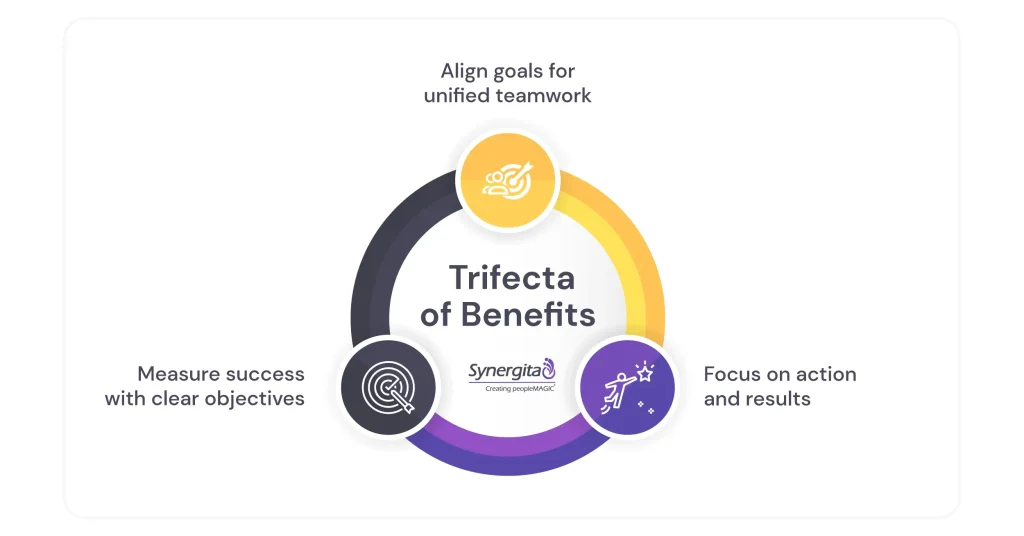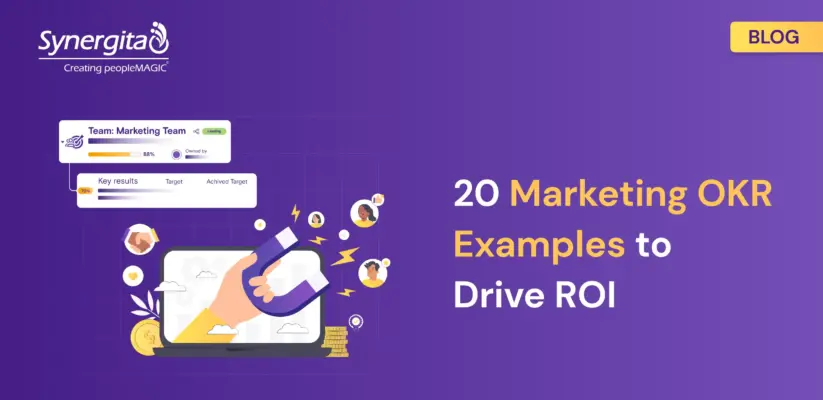20 Marketing OKR Examples to Drive ROI
The marketing conundrum – not directly selling, but very much affects sales, is responsible for brand engagement, but new clients are not always directly credited to it. And the list doesn’t end there. The marketing team is possibly one of those crucial teams that has some of the seemingly most intangible targets and outcomes.
Measuring the return on investment (ROI) of marketing initiatives, particularly those focused on brand building, can also be challenging, as can standing out in a competitive environment. However, marketing teams possess unique advantages, such as the opportunity to innovate creatively, deeply understand their target audience, and build strong brand identities and relationships. OKRs (Objectives and Key Results) are well-suited to address these challenges and leverage these strengths. By aligning marketing objectives with broader business goals, OKRs ensure that efforts contribute directly to organizational success. Additionally, OKRs encourage focus, prioritization, and accountability, while also promoting agility, adaptability, and a culture of continuous improvement. With clear, measurable outcomes and a structured framework, OKRs provide marketing teams with the tools they need to drive impactful results and navigate the complexities of their role effectively.
How Marketing OKRs Provide Clarity
Marketing teams are often told to increase brand awareness, but while this goal is important, it lacks specificity and clarity, making it difficult to measure progress or determine success. By contrast, an OKR could provide a more focused and measurable approach. For example, the objective could be to “boost brand awareness among millennial consumers in urban areas”. This objective provides a clear target audience and geographic focus. The key results could then include three specific metrics, such as “increase Instagram followers by 20% among users aged 18-34 in metropolitan areas”, “achieve a 15% increase in website traffic from cities with a population over 1 million”, and “secure coverage in at least three local lifestyle publications with a combined circulation of 100,000”. These key results offer concrete, measurable ways to achieve the larger goal of the company. It provides clear direction and enables the marketing team to track progress and success effectively.

What Goes into Setting OKRs for Marketing Teams?
Specific sales or product development targets elude marketing teams, which must work towards a company’s larger vision, keeping in mind the big picture while working on day-to-day strategic initiatives.
The dynamic nature of marketing functions, with its various focus areas and specialized expertise, requires a thoughtful approach to goal setting. It must have a collaborative approach that incorporates input from all levels. OKRs can ensure that the plans are relevant, achievable, and aligned with the organization. Marketing OKRs are not only meaningful but also contribute effectively to overarching organizational goals. Additionally, fostering collaboration with other teams, such as sales, customer success, and product teams, promotes synergy and alignment, enabling cohesive efforts toward shared objectives.
Get Started with 20 Marketing OKR Examples
To help you get started on the diverse areas that marketing teams cover, here are 20 examples that can provide you with some direction that marketing teams can take to break down goals and effectively strategize to achieve a stronger brand image that translates to higher sales and ROI.
1. Enhance Social Media Management
Objective: Boost social media engagement to increase brand visibility and audience interaction.
KR1: Increase Instagram post engagement rate by 20%.
KR2: Achieve an average of 100 comments per Facebook post.
KR3: Host a Twitter chat bi-weekly to encourage real-time interaction.
2. Expand Email Subscriber Base
Objective: Grow the email subscriber list to nurture leads and drive conversions.
KR1: Increase email subscriber count by 25%.
KR2: Achieve a 20% open rate for monthly newsletters.
KR3: Implement a referral program to acquire new subscribers, aiming for 500 referrals.
3. Improve Website Conversion Rates
Objective: Optimize website performance to increase conversion rates and enhance user experience.
KR1: Decrease bounce rate by 15%.
KR2: Achieve a 10% increase in overall website conversion rate.
KR3: Implement A/B testing for landing pages to identify and implement high-converting designs.
4.Enhance Content Marketing Strategy
Objective: Strengthen content marketing efforts to drive organic traffic and engage the target audience.
KR1: Increase blog traffic by 30% through SEO optimization.
KR2: Publish one high-quality video per month to improve user engagement.
KR3: Launch a quarterly e-book series focusing on industry trends and insights.
5. Boost Brand Awareness
Objective: Increase brand visibility and recognition among the target audience.
KR1: Secure at least three features in prominent industry publications.
KR2: Launch a social media influencer campaign to reach 1 million impressions.
KR3: Sponsor and participate in a major industry event to increase brand exposure.
6. Drive Product Adoption
Objective: Promote product adoption and usage among target customers.
KR1: Increase free trial sign-ups by 50%.
KR2: Achieve a 20% increase in active users within the first month of onboarding.
KR3: Launch a customer education webinar series to showcase product features and best practices.
7. Optimize Paid Advertising Campaigns
Objective: Improve the ROI of paid advertising campaigns to drive qualified leads.
KR1: Increase Google Ads conversion rate by 15%.
KR2: Reduce cost per acquisition (CPA) by 20% across all paid channels.
KR3: Implement retargeting campaigns to increase conversion rates for abandoned carts by 25%.
8. Enhance Customer Experience
Objective: Provide exceptional customer experiences to increase satisfaction and loyalty.
KR1: Achieve a customer satisfaction (CSAT) score of 90% or higher.
KR2: Reduce average response time to customer inquiries by 50%.
KR3: Implement a customer feedback program to gather insights and drive continuous improvement.
9. Launch New Product Successfully
Objective: Ensure the successful launch of a new product to drive revenue growth.
KR1: Achieve 1000 pre-orders before the product launch date.
KR2: Generate positive reviews and ratings with an average rating of 4.5 stars or higher within the first month.
KR3: Secure coverage in at least five major media outlets to generate buzz around the launch.
10. Improve Marketing Attribution
Objective: Enhance marketing attribution models to accurately measure the impact of marketing efforts.
KR1: Implement a multi-touch attribution model to track customer journeys across all touchpoints.
KR2: Achieve a 20% increase in marketing-attributed revenue.
KR3: Analyze and optimize top-performing channels based on attribution data to maximize ROI.
11. Expand International Market Reach
Objective: Expand market reach to new international regions to drive global growth.
KR1: Launch localized marketing campaigns in three new international markets.
KR2: Increase website traffic from international audiences by 50%.
KR3: Establish partnerships with local influencers or brands to increase brand awareness in target regions.
12. Improve Social Media Advertising Efficiency
Objective: Enhance the efficiency of social media advertising to optimize budget utilization.
KR1: Decrease cost per click (CPC) by 15% across all social media platforms.
KR2: Increase return on ad spend (ROAS) by 20% for Facebook ad campaigns.
KR3: Implement audience segmentation and personalized messaging to improve ad relevance scores.
13. Drive Thought Leadership
Objective: Establish the company as a thought leader in the industry to attract prospects and talent.
KR1: Publish monthly thought leadership articles on industry trends and insights.
KR2: Increase speaking engagements at industry conferences and events by 50%.
KR3: Launch a podcast series featuring interviews with industry experts and influencers.
14. Improve Website Accessibility and Inclusivity
Objective: Enhance website accessibility and inclusivity to provide a seamless experience for all users.
KR1: Achieve compliance with WCAG 2.1 AA standards for website accessibility.
KR2: Conduct user testing with diverse groups to identify and address accessibility barriers.
KR3: Implement alternative text for images and captions for videos to improve accessibility for visually impaired users.
15. Increase Customer Retention
Objective: Improve customer retention rates to foster long-term relationships and recurring revenue.
KR1: Launch a customer loyalty program to incentivize repeat purchases and referrals.
KR2: Reduce churn rate by 20% through targeted retention campaigns and personalized communication.
KR3: Implement proactive customer support strategies to address potential issues and enhance satisfaction.
16. Enhance Cross-Selling and Upselling
Objective: Increase revenue through cross-selling and upselling strategies to maximize customer lifetime value.
KR1: Achieve a 30% increase in revenue from cross-selling complementary products or services.
KR2: Implement personalized recommendations based on customer behavior and purchase history.
KR3: Train sales and customer success teams on cross-selling and upselling techniques to drive adoption.
17. Improve Organic Search Visibility
Objective: Strengthen organic search visibility to drive qualified traffic and increase rankings.
KR1: Increase organic search traffic by 25% through content optimization and link building.
KR2: Improve keyword rankings for target keywords to reach the top three positions in search results.
KR3: Implement schema markup and structured data to enhance search engine visibility and click-through rates.
18. Enhance Event Marketing Strategy
Objective: Optimize event marketing strategy to maximize brand exposure and lead generation.
KR1: Increase event attendance by 50% compared to the previous year.
KR2: Generate a minimum of 500 new leads from each major industry event attended.
KR3: Implement post-event follow-up campaigns to nurture leads and drive conversions.
19. Improve Sales and Marketing Alignment
Objective: Foster better alignment between sales and marketing teams to improve collaboration and efficiency.
KR1: Implement a lead scoring system to prioritize and route leads effectively between sales and marketing.
KR2: Increase the percentage of marketing-generated leads accepted by sales by 20%.
KR3: Hold regular joint meetings and workshops to align goals, messaging, and strategies between sales and marketing.
20. Enhance Competitor Analysis and Benchmarking
Objective: Improve competitor analysis and benchmarking to identify opportunities and stay ahead of industry trends.
KR1: Conduct quarterly competitive analysis to track market share, pricing, and product offerings.
KR2: Identify and analyze key competitors’ marketing strategies and tactics to inform future initiatives.
KR3: Benchmark marketing performance metrics against industry peers and set targets for improvement.
OKR: A Tool for Every Situation
Marketing OKRs are versatile tools suitable for various types of organizations. Across industries, marketing OKRs provide clarity, alignment, and measurable outcomes for marketing success. Startups and SMEs leverage OKRs to focus limited resources on impactful marketing strategies, such as increasing brand awareness or driving customer acquisition. Large corporations with multiple marketing teams use OKRs to align diverse efforts with overarching marketing objectives, ensuring cohesion across departments, while e-commerce companies rely on OKRs to stay ahead in competitive markets, setting objectives like boosting monthly active users or improving website conversion rates.
Taking your business to the next level is just a step away. The intuitive, dynamic Synergita OKR platform works for you to iron out any roadblocks that you may have on your new journey. Offering a plethora of customizable templates, Synergita OKR can be your trusted guide to achieve excellence. To know more about Synergita OKR visit the website or sign up to experience the efficacy of OKRs today!
